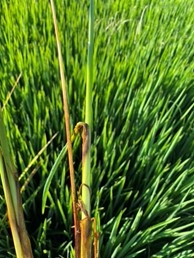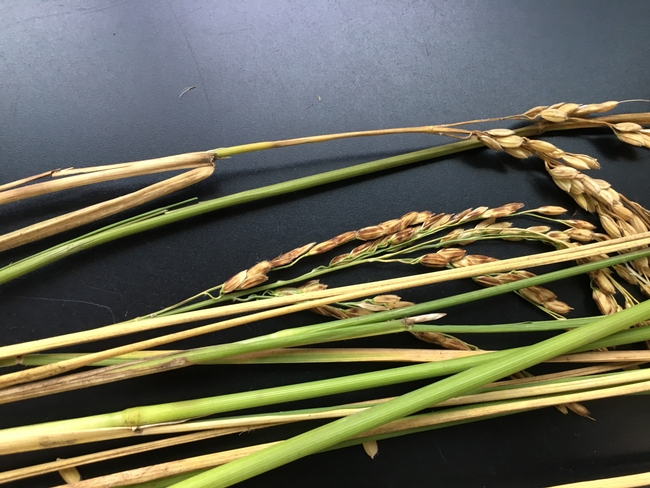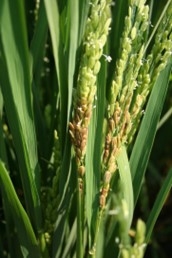Thankfully, 2022 was not a bad year for rice diseases, but it is worth mentioning a couple of observations. Overall, there was very little blast this year. In the Sacramento Valley, UCCE did not diagnose any blast in the field but did receive a couple reports of it after harvest.
Blast was identified in the San Joaquin Delta in a field of M-206. Blast in the Delta is a rare occurrence because of the cooler temperatures in the area. In fact, UCCE has only identified blast there once before. Back in 2010, one Delta field of variety M-104 was confirmed as infected with blast. Year 2010 was a bad blast year, with many fields affected across the Sacramento Valley.
Blast can infect seed, it can survive in crop residue, and its spores can move long distances. Additionally, weeds are suspected to be alternate hosts. All these factors can be sources of inoculum that can result in a blast epidemic. In seed, the mycelium of the blast fungus has been found colonizing the internal surfaces of the lemma and palea (the seed coat), the pericarp and endosperm. Unfortunately, treating the seed with bleach for bakanae does not help with the blast fungus. In general, seed is not considered a major source of blast inoculum in California. Until a few years ago, certified seed used to be tested for blast. The requirement for this test was stopped in 2018 because results were always negative. However, if during the certification inspection a seed field or a portion of a seed field is identified as infected with blast, that field or portion can be rejected. Research has shown that under water seeding, there is no seed to seedling blast transmission. Seedling transmission has been documented from infected seeds planted in soil or infected seeds that remain on the soil surface. Given that most of the acreage in California is water seeded, the risk of infected seed producing blast inoculum is low. However, in the Delta, where rice is drill seeded, the risk is higher.
While disease was low overall, we did come across another fungus that is relatively new to us. A report of possible blast in M-211 was received in late summer form a PCA in Butte County. Inspection of the field revealed only a few plants affected with symptoms that looked like collar blast (Fig. 1). Samples were submitted to the UC Davis Plant Pathology Lab, and the identification came back as Nigrospora oryzae, which causes “panicle branch rot”. Interestingly, this fungus was also identified in three Delta fields (Fig. 2), one of which also had blast. Prior to 2022, we identified this fungus from samples with symptoms similar to stem rot in 2017 and 2021, and in a field with heavy discoloration of rice panicles in 2021 (Fig. 3).
The Compendium of Rice Diseases and Pests (2018, APS Press) indicates that Nigrospora species are common and occur in senescing plant tissue, and may cause lesions in plants weakened by diseases, insects, or poor nutrition. This fungus is reported to cause an ear blight and blackening of rice kernels. These descriptions fit the symptoms mentioned above. Additionally, Nigrospora oryzae has recently been identified as the causal agent of panicle branch rot disease in China (Liu et al., 2021, Plant Disease 105 (9): 2724), a disease very similar to blast, with reported yield and quality losses.
It is not clear if this fungus is developing in tissues that are already affected by stem rot or blast, or if it is causing disease symptoms. In any case, given the information in the literature and the low frequency of observation, at this point the identification of Nigrospora oryzae from California rice samples is not cause for concern, but it does warrant vigilance from the industry. Please reach out to us in the future if you see symptoms similar to these so that we can gather more information about this fungus.


